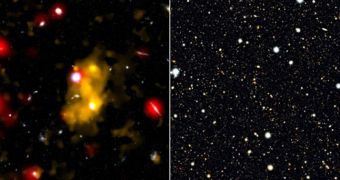Lyman-alpha blobs (LAB) are, quite simply put, the largest things in the Universe. They dwarf galaxies, and, when they were first discovered about a decade ago, seemed to only exist to annoy astronomers. Made entirely out of hydrogen gas, the blobs also glow, a feat that has had astrophysicists thinking for years. Now, a team of experts from the University of Durham, led by Astronomer James Geach, have discovered that the light these clouds emit may actually be due to the radiations emitted by supermassive black holes at their center.
If it turns out to be true, this theory would add further evidence to a growing idea in the astronomical community, which holds that the behemoth black holes at the centers of massive galaxies are the main reason why these formations do not grow beyond a certain point. In other words, as the galaxy and the black hole expand, the entire group comes to a point where the rate of growth registered by the black hole consumes too much matter from the galaxy, forcing it to maintain its size.
In their investigations of sky patch SSA 22, DU experts, using the American space agency's Chandra X-ray telescope, managed to observe the behaviors of no less than 29 blobs. The observed LAB were of impressive size, reaching a diameter of a few hundred thousand light-years across, ScienceNow informs. According to calculations, the formations that were recently analyzed are extremely old, dating back to the time when the Universe was just two billion years old. At this point, the age of the Cosmos is estimated to be at around 13.7 billion years.
When looking at the formations with NASA's telescope, the team saw that X-rays emitted from the blobs were in fact coming from supermassive black holes at their cores. When analyzing the signature of these structures, they realized that, in all five of the blobs through which they could look, black holes lurked at their center. Using the agency's Spitzer Space Telescope, the investigators also noticed areas of stellar formation in the LAB. This means that the light the hydrogen gas clouds give off is caused by the radiation generated when matter falls through the event horizon of a black hole, and also when energy is released from young, forming stars.
In an upcoming issue of The Astrophysical Journal, Geach wrote that the blob stage might be one of the main stages in galaxy formation. “Massive galaxies must go through a [blob] stage, or they would form too many stars and end up ridiculously large,” the Co-author of the paper, DU Astronomer Bret Lehmer, added. “What we are seeing could be the signatures of galaxies coming of age,” Geach said on Wednesday, in a press conference.

 14 DAY TRIAL //
14 DAY TRIAL //